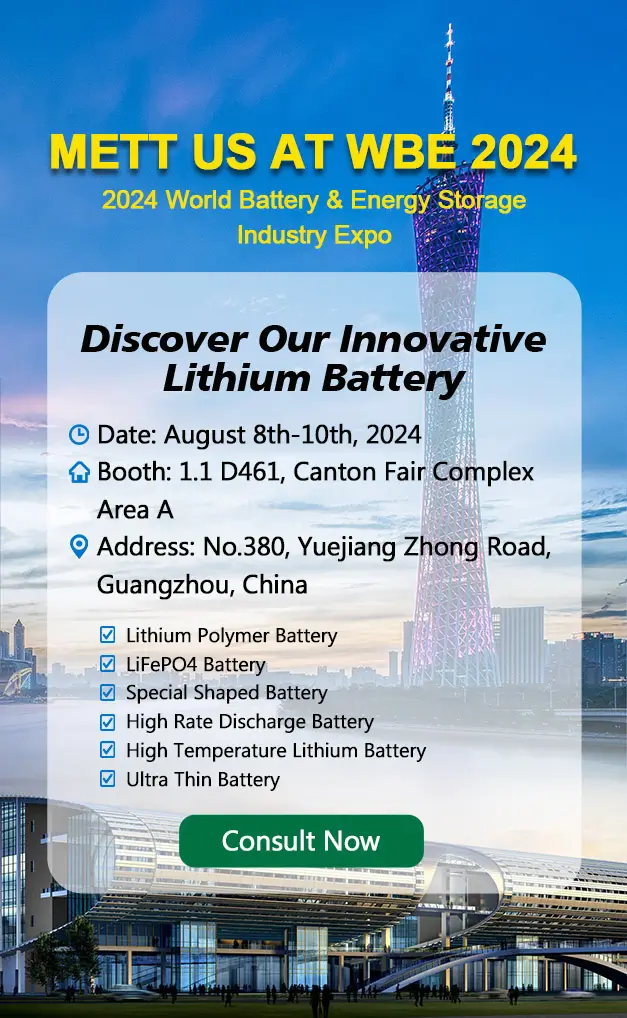Nickel-cadmium (Ni-Cd) and nickel metal hydride (Ni-MH) batteries are rechargeable battery technologies with unique characteristics. Understanding the nuances between these two technologies is crucial for making informed decisions across industries. This exploration delves into their comparative advantages, disadvantages, and distinctions, aiding in choosing the optimal battery solution for specific needs.
Part 1. Nickel-cadmium battery (Ni-Cd)
History
The Nickel-Cadmium (Ni-Cd) battery has a fascinating historical backdrop, pioneered by Waldemar Jungner in 1899. Jungner’s invention marked a significant leap in portable power sources. However, it was in the 1940s that Ni-Cd batteries became commercially viable, owing to advancements in technology and manufacturing processes. This breakthrough revolutionized portable electronics and various industries’ reliance on rechargeable power.
What are Ni-Cd Batteries?
Ni-Cd batteries consist of a positive electrode made of nickel hydroxide (Ni(OH)2) and a negative electrode composed of cadmium (Cd). An alkaline electrolyte solution separates these electrodes. This chemical arrangement allows reversible electrochemical reactions during charging and discharging cycles, facilitating the battery’s reusability.
Applications
Consumer Electronics: Ni-Cd batteries initially powered early portable radios and flashlights. Their rechargeability made them famous in mobile devices, including cameras, handheld gaming consoles, and personal music players.
Power Tools: Their ability to handle high discharge rates made Ni-Cd batteries ideal for power tools like drills, saws, and screwdrivers, where consistent power delivery and durability were essential.
Aviation and Aerospace: Ni-Cd batteries were employed in aircraft emergency systems, offering reliable power in critical situations. Their capacity to function in extreme temperatures made them suitable for aerospace applications.
Telecommunications: They served as backup power sources for telecommunications equipment due to their quick recharge capabilities and reliability during power outages.
Medical Devices: Ni-Cd batteries powered various medical devices, such as portable defibrillators and infusion pumps, where consistent and rechargeable power was crucial.
Part 2. Ni-Cd battery advantages
Robust Performance in High-Drain Devices
Ni-Cd batteries excel in applications with high-drain devices, such as power tools and specific electronic gadgets. Their ability to deliver a consistent power flow under heavy loads makes them indispensable in scenarios where rapid and sustained energy release is crucial.
Resilience in Extreme Temperatures
A distinctive advantage of Ni-Cd batteries is their ability to function optimally in various temperatures. This makes them particularly valuable in applications like aerospace, where temperature variations are prevalent, ensuring reliable power performance under challenging environmental conditions.
Long Operational Lifespan
When subjected to proper care and maintenance, Ni-Cd batteries demonstrate a prolonged operational lifespan. Their durability and resistance to overcharging contribute to an extended service life, making them cost-effective for applications that demand lasting battery performance.
Tolerance to Overcharging
Ni-Cd batteries are known for their tolerance to overcharging, a characteristic that enhances their durability. This feature is particularly beneficial when precise control over charging cycles may be challenging, providing flexibility without compromising battery health.
Quick Recharge Capability
Ni-Cd batteries boast a fast recharge capability, making them suitable for applications that require minimal downtime. This advantage is precious in environments where devices must be rapidly replenished with power, enhancing overall operational efficiency.
Reliable Performance at Lower Temperatures
Unlike other battery types, Ni-Cd batteries maintain reliable performance even in lower temperatures. This attribute extends their usability in cold environments, making them suitable for applications where temperature resilience is critical.
Well-Suited for Emergency Systems
The robust and reliable nature of Ni-Cd batteries positions them as an excellent choice for emergency systems, providing a dependable power source during critical situations. Their ability to deliver instant power makes them indispensable in applications like backup lighting and emergency communication systems.
Low Self-Discharge Rate
Ni-Cd batteries exhibit a relatively low self-discharge rate, allowing them to retain stored energy for longer durations without significant loss. This makes them suitable for devices with infrequent use, ensuring that the battery remains ready for action when needed.
Part 3. Ni-Cd battery disadvantages
Environmental Concerns
The most prominent drawback of Ni-Cd batteries revolves around environmental issues. These batteries contain cadmium, a toxic heavy metal. Improper disposal or mishandling can contaminate soil and water, posing significant ecological hazards. Efforts to mitigate these concerns involve stringent recycling programs, but environmental impact remains critical.
Memory Effect
Ni-Cd batteries are susceptible to the memory effect. In this phenomenon, the battery’s capacity diminishes if not fully discharged before recharging. This reduces the adequate capacity over time, affecting overall performance and necessitating careful management to prevent this effect.
Lower Energy Density
Compared to newer battery technologies, Ni-Cd batteries exhibit lower energy density. This limitation means they store less energy per unit volume or weight than more advanced batteries like Nickel Metal Hydride (Ni-MH) or Lithium-ion (Li-ion), affecting their overall efficiency in specific applications.
Efficiency Reduction from Partial Charging
Ni-Cd batteries are less tolerant of partial charging compared to newer battery types. Regularly recharging them without fully depleting their charge can diminish their capacity over time, affecting their overall efficiency and performance.
Part 4. Nickel metal hydride battery (Ni-MH)
History
The Nickel Metal Hydride (Ni-MH) battery, a significant advancement in rechargeable battery technology, emerged in the late 1980s. Its development stemmed from the quest for a more environmentally friendly alternative to Nickel Cadmium (Ni-Cd) batteries. This breakthrough resulted from pioneering research and innovation in materials science and electrochemistry.
What are Ni-MH Batteries?
Ni-MH batteries utilize a positive electrode made of nickel oxyhydroxide (NiOOH) and a negative electrode incorporating a hydrogen-absorbing alloy, typically of rare earth metals or metal hydrides. The electrolyte, usually potassium hydroxide (KOH), enables the movement of ions between the electrodes during charge and discharge cycles.
Applications
Consumer Electronics: Ni-MH batteries quickly gained popularity in consumer electronics due to their higher energy density compared to Ni-Cd batteries. They became common in digital cameras, portable gaming consoles, and MP3 players, providing longer-lasting power and reduced memory effects.
Electric Vehicles (EVs) and Hybrid Vehicles: Ni-MH batteries’ higher energy density and reduced environmental impact made them suitable for use in electric and hybrid vehicles. Although Lithium-ion batteries have superseded their usage in this sector, they played a significant role in the early development of electric transportation.
Medical Devices and Tools: Ni-MH batteries found applications in various medical devices, such as portable medical equipment and tools, owing to their improved energy storage capacity and reduced toxicity compared to Ni-Cd batteries.
Renewable Energy Storage: Due to their decent energy storage capabilities and reliability, they have been used in renewable energy storage applications, such as solar-powered systems and backup power sources.
Portable Power Banks and Emergency Devices: Ni-MH batteries are employed in mobile and emergency devices for their rechargeability and moderate energy density, ensuring a reliable emergency power source.
Part 5. Ni-MH battery advantages
Higher Energy Density
Ni-MH batteries offer a notably higher energy density than their predecessor, Ni-Cd batteries. This enhanced energy storage capacity allows for longer-lasting power in compact sizes, making them suitable for applications requiring prolonged usage without frequent recharging.
Reduced Toxicity
One of the significant advantages of Ni-MH batteries is their reduced environmental impact compared to Ni-Cd batteries. They contain no cadmium, a toxic material found in Ni-Cd batteries, making Ni-MH batteries a more environmentally friendly choice.
Lower Susceptibility to Memory Effect
Ni-MH batteries exhibit a reduced susceptibility to the memory effect, allowing for more flexible charging patterns. Unlike Ni-Cd batteries, Ni-MH batteries can be recharged at any state of discharge without significant impact on their overall capacity.
Enhanced Safety Profile
Ni-MH batteries are generally safer than other battery types, like Lithium-ion, due to their stable chemistry and reduced risk of thermal runaway or fire hazard. This safety aspect makes them suitable for applications requiring higher safety assurance.
Compatibility with Rapid Charging
Ni-MH batteries can handle rapid charging cycles effectively without compromising their lifespan. This feature is beneficial for devices that require quick power replenishment, ensuring minimal downtime for users.
Reliability in Various Temperatures
Ni-MH batteries maintain reliable performance across various temperatures, making them suitable for applications in diverse environments, including high and low-temperature conditions.
Longer Cycle Life
Ni-MH batteries demonstrate a longer cycle life than Ni-Cd batteries, offering a more significant number of charge and discharge cycles before experiencing a notable decline in performance. This extended cycle life contributes to their durability and longevity in use.
Cost-Effectiveness
Ni-MH batteries present a cost-effective solution due to their longer lifespan, reduced environmental impact, and compatibility with existing charging infrastructure, making them a practical choice for various applications.
Part 6. Ni-MH battery disadvantages
Self-Discharge Rate
Ni-MH batteries have a higher self-discharge rate than other rechargeable battery types. They lose stored energy more rapidly when not in use, affecting their usability for devices requiring intermittent or infrequent use.
Limited High-Current Applications
While Ni-MH batteries offer improved energy density compared to Ni-Cd, they are less adept at handling high-current applications than other battery technologies. This limitation may restrict their usage in devices that demand exceptionally high power output.
Sensitivity to Overcharging
Ni-MH batteries are sensitive to overcharging, which can lead to reduced battery lifespan and capacity. Careful monitoring and regulation of charging cycles are necessary to prevent overcharging, affecting their overall convenience.
Memory Effect
Although less susceptible than Ni-Cd batteries, Ni-MH batteries may still experience a mild memory effect if consistently recharged without being fully discharged. This can lead to a gradual reduction in overall capacity and performance over time.
Complex Disposal Requirements
Like many rechargeable batteries, Ni-MH batteries require specialized recycling procedures due to their chemical composition. Proper disposal can be complex and costly, adding to the environmental impact of battery waste.
Part 7. Difference between Ni-Cd battery and Ni-MH battery
Chemical Composition
The primary difference lies in their chemical compositions. Ni-Cd batteries utilize cadmium as the negative electrode and nickel hydroxide as the positive electrode, immersed in an alkaline electrolyte. On the other hand, Ni-MH batteries employ a hydrogen-absorbing alloy as the negative electrode and nickel oxyhydroxide as the positive electrode, also using an alkaline electrolyte.
Energy Density
Ni-MH batteries offer a higher energy density compared to Ni-Cd batteries. This difference allows Ni-MH batteries to store more energy per unit volume or weight, providing longer-lasting power for devices without being as bulky as Ni-Cd batteries.
Environmental Impact
Ni-MH batteries are considered more environmentally friendly than Ni-Cd batteries due to their composition’s absence of toxic cadmium. Ni-Cd batteries pose environmental concerns due to the presence of cadmium, which can lead to soil and water contamination if not correctly disposed of.
Memory Effect
Ni-Cd batteries are more prone to memory effects compared to Ni-MH batteries. Ni-Cd batteries require full discharge before recharging to prevent the memory effect. In contrast, Ni-MH batteries exhibit a reduced susceptibility to this phenomenon, allowing for more flexible charging patterns.
Charging Characteristics
Ni-MH batteries can handle rapid charging better than Ni-Cd batteries. Ni-MH batteries tolerate quick charging cycles without adversely affecting their longevity. In contrast, Ni-Cd batteries may experience reduced lifespan if frequently subjected to rapid charging.
Weight and Size
Ni-Cd batteries tend to be heavier and bulkier than Ni-MH batteries with similar energy capacities. With their higher energy density, Ni-MH batteries offer a more compact and lightweight alternative for specific applications.
Applications
Ni-Cd batteries were widely used for various applications, such as power tools and consumer electronics. However, Ni-MH batteries have gradually replaced Ni-Cd batteries in many applications due to their improved characteristics and reduced environmental impact.
Part 8. FAQs
-
Are nickel-cadmium and NiMH batteries interchangeable?
Generally, NiCd (Nickel Cadmium) and NiMH (Nickel Metal Hydride) batteries have different characteristics and charging requirements. While they share some similarities, they are only partially interchangeable due to differences in voltage, capacity, and charging methods. -
Can I charge a NiMH battery with a NiCad charger?
It’s not recommended to charge NiMH batteries with a NiCad charger. NiMH batteries have different charging requirements, and using a NiCad charger might not fully charge or could damage the NiMH battery due to differences in setting algorithms. -
How do I know if my battery is NiCd or NiMH?
Typically, you can distinguish between NiCd and NiMH batteries by checking their labels or packaging. Also, NiMH batteries often have a higher capacity rating than NiCd batteries of similar size. -
Do NiMH batteries last longer than alkaline ones?
NiMH batteries generally last longer than alkaline batteries in terms of rechargeability and the number of charge cycles. However, in a single-use scenario, alkaline batteries might have longer shelf life but lower total capacity than NiMH batteries.
Related Tags:
More Articles

Overview of Deep Cycle Lithium Battery
In this article, we explore the life, voltage, capacity, and charging considerations of deep cycle lithium batteries.
How Long do Lithium Batteries Last?
How long do lithium batteries last? we will explore the factors that influence the lifespan of lithium batteries and provide insights into their longevity.
How to Choose the Best LiFePO4 Battery?
Choose LiFePO4 batteries for superior performance, safety, and versatility in EVs, UPS, and backup power. This guide helps you make informed decisions.
Get 12v Lithium Car Battery As a Power Source for the Ride
Make the right choice for your vehicle's battery needs by installing a 12 volt lithium car battery. You will enjoy maintenance-free longevity with this change.
Everything About A Small Lithium Ion Battery
Discover the features, uses & future potential of a small lithium ion battery. A compact and tiny powerhouse ideal for smartphones, wearables, drones & more.





